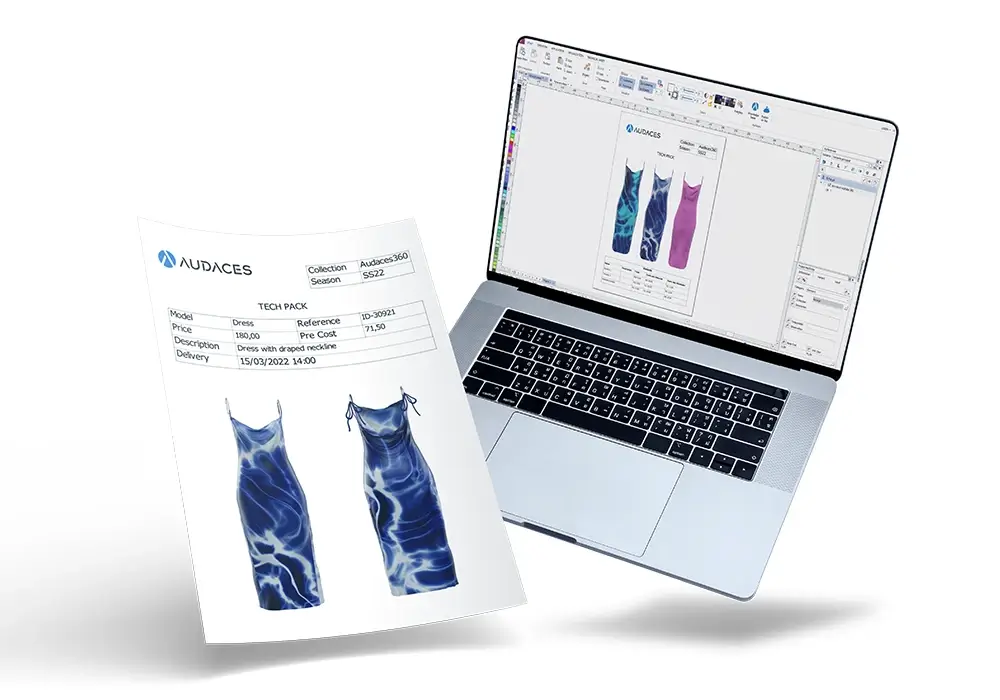Summary
- Product warranties in the fashion industry are essential for both customers and companies.
- People highly value the quality and durability of garments.
- Try a new way to create your clothing pieces. Try Audaces360 multi-solution for free.
Ensuring consumer satisfaction is one of the pillars of success for any company, especially in the apparel industry.
Product warranties protect consumer rights and build trust in the brand. They help companies stand out in a highly competitive market.
Learn about product warranty policies, how to implement them, and best practices for managing recall situations.
Happy reading!
Sumário
Why is it important to have fashion product warranty policies?
Having fashion product warranty policies is essential to earning customer trust and loyalty.
They ensure that if the customer finds any issues with the product, they have the right to an exchange or refund.
This is especially important in the fashion sector, where people highly value quality and durability.
Additionally, a warranty policy shows that the brand trusts the quality of its products.
When a company offers a warranty, it is essentially saying that its products are reliable and safe.
This can set the brand apart from competitors, making it more attractive to consumers.
Furthermore, a good warranty policy enhances the customer experience by making the purchasing process smoother and worry-free.
If the customer can rely on the company, they are more likely to buy again in the future and even recommend the brand.
How to define your fashion product warranties?
Defining product warranties for your fashion business involves several important steps. Here’s how:
Understand local legislation
First and foremost, it’s crucial to understand the consumer protection laws that apply to your business. Many countries have a Consumer Protection Code (CPC):
- Most Latin American countries have a CPC, which came into effect in the 1990s. Brazil was a pioneer in adopting specific legislation on the subject.
- In the European Union, Directive 6 defined the concept of misleading and anti-competitive advertising.
- In Japan, the legislation distinguishes between common contracts and consumer contracts.
- China also has special conflict of law rules for contracts between suppliers and consumers.
Consumer protection is codified in some countries, such as Brazil, Italy, France, Catalonia, Luxembourg, and the Czech Republic.
In countries like Germany, the Czech Republic, and the Netherlands, consumer law are in the civil code.
Consumer protection is often regulated alongside competition protection.
Define the warranty duration
Based on local legislation and the quality of your products, set the warranty duration you will offer.
You may choose to offer a warranty beyond the legal minimum, which can boost consumer confidence in your brand.
Create a warranty request process
A clear and simple process for customers to request warranty services is essential.
Clear information
Include details about the warranty policy at all points of sale, website, and marketing materials. This should cover the warranty duration, what it covers, and the steps to take to request it.
Communication channel
Set up a dedicated communication channel for warranty issues, such as a specific email or a phone number.
Ensure customers know how to get in touch.
Documentation
Request proof of purchase and a description of the problem from the customer. Photos or videos of the defect can also be helpful.
Evaluation
Create an internal procedure to evaluate warranty requests.
Determine who will be responsible for the evaluation and how long it will take to respond to the customer.
Solutions
Define the solutions you will offer, such as repairs, replacements, or refunds, and in which situations each applies.
Have clear policies for products that aren’t easy to repair or replace.
3 defects your product warranties should cover

To ensure customer satisfaction and safety, your fashion product warranty should cover the following defects:
1) Manufacturing defects
Any failure or defect resulting from the manufacturing process should be covered by the warranty. It includes poor seams, loose buttons, broken zippers, fabric weave or dye defects.
This type of coverage ensures that the customer will not keep a product that fails to meet quality standards.
2) Items that do not meet requirements
Safety uniforms and other products must comply with regulatory standards, such as NR-24 in Brazil. It sets requirements for hygiene, comfort, and safety in the workplace.
If any part of the product doesn’t meet these standards, the warranty should cover the replacement or correction.
This ensures that all products offer the appropriate level of protection and comfort to workers.
3) Product features that pose a risk
The warranty should also cover any product feature that poses a health or safety risk to the user.
This includes, for example, the use of wrong materials that are not sufficiently flame-resistant, creating a fire hazard.
Fashionable products, especially those intended for use in specific environments, must be safe.
Therefore, the warranty should cover any defect that poses a risk of injury, allergies, or other health problems.
This reinforces the brand’s commitment to customer safety and well-being.
How to streamline the recall process in your fashion business?

Streamlining the recall process in your business is essential to ensure consumer safety and maintain trust in your brand.
Here are practical steps to set up an efficient recall process:
Identify the manufacturing defect
Conduct rigorous quality inspections at every production stage. This helps detect problems before the products reach the market.
Encourage customers to provide feedback on products and respond promptly to any complaints.
Learn more: How can fashion brands boost their business with technology?
Track your products via SKU
Tracking products via SKU (Stock Keeping Unit) is crucial for quickly locating defective items.
This makes it easier to identify and track products throughout the supply chain.
Maintain detailed records of each production batch, including information about material suppliers, production dates, and specific batches.
This helps quickly identify which products may suffer from a specific defect.
Learn more: Discover 8 best practices for optimizing apparel inventory management
Find the cause in the spec sheet
Review the spec sheet of the product to identify possible flaws in the design, material, or manufacturing process.
The spec sheet should include all details about the materials used, production methods, quality specifications, and tests performed.
Conduct a root cause analysis to determine why the defect occurred.
This may involve additional testing, consulting with material suppliers, and reviewing manufacturing procedures.
After identifying the cause of the problem, implement the necessary corrections in production.
Update the spec sheets to reflect any changes in processes or materials.
Learn more: Uncover 5 expert tips on how to create a tech pack successfully
Facilitate product warranty creation with Audaces solutions

Audaces Idea is part of the Audaces360 multi-solution and simplifies the management of fashion product warranties.
Audaces Idea
Audaces Idea is a solution that facilitates the creation and management of product warranties in fashion businesses, offering complete and accurate traceability.
It allows you to keep a record of all production data, including spec sheets, patterns, materials, and design.
This level of detail is essential for identifying any problems that may arise with the product after sale. The software makes traceability easier, helping to understand the root cause of any product failure.
The spec sheet helps determine whether the issue is related to production, design, or materials.
With all these features, Audaces Idea makes the process of creating and managing warranties much more efficient.
Quick and accurate access to all production information helps you spot problems. This lets you make informed decisions and support customers effectively.
This not only improves product quality but also strengthens customer trust in your brand.
We created a quick guide for designing fashion tech packs! Download it now and get two exclusive free spreadsheets:
FAQ
Having fashion product warranty policies is essential to earning customer trust and loyalty. They ensure that if the customer finds any issues with the product, they have the right to an exchange or refund.
Understand local legislation, set the warranty duration, and establish a warranty claim process.
Identify manufacturing defects, track your products by SKU, and find the cause in your tech pack.










